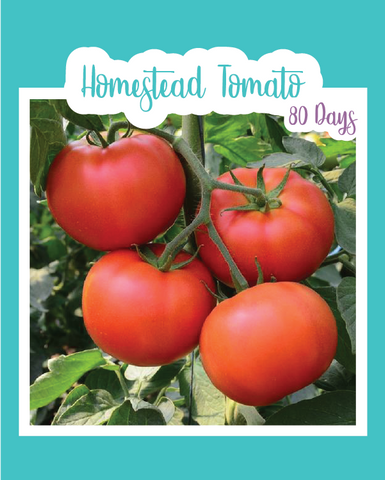
Rutgers VF Tomato
Determinate
Seed Count: Approx. 10 seeds
Days to Maturity: 60-70 Days
Description: The Rutgers VF tomato consistently produces flattened, globe shaped, all purpose, red fruits. This variety is great for canning or slicing and eating fresh on sammiches. It has been around since the early 1900s, and was originally developed at Rutgers University in cooperation with the Campbell's Soup Company. The 6-12 oz. fruit grow on 3 ft., strong, determinate vines, and hold their shape well while being sliced. Its flesh is thick, acidic, and flavorful, and has a good flesh to gel ratio, without giving you too many seeds per slice. Their smooth skins are crack very resistant. This variety always grows really well for me in SoFlo, and is definitely one of my favorite slicer varieties to grow. The Rutgers VF variety is a Verticillium and Fusarium wilt resistant cultivar, and its disease resistance is mainly why it's quite easy to grow!
How To Grow
Sowing: Start tomatoes indoors 6-8 weeks before the last frost of spring, or direct sow in warmer climates. Sow seeds 1/4" deep and 1" apart. Tomatoes need 70-75 degrees F to germinate, as well as adequate light. Keep the soil moist, but make sure there is proper drainage, or the seeds can rot. When the second set of leaves emerge, transplant the seedlings into individual pots. Bury the stems up to the lowest set of leaves for strongly rooted plants.
Growing: This variety is determinate, and doesn't require a trellis, however, I tend to still provide supports when there is heave fruit set to keep my branches from breaking and my fruit off the ground. Protect plants, if temperature drops below 55 degrees F, or damage will occur. Keep soil consistently moist, or cracking may also occur. Mulching can be beneficial to preserve moisture, and deter weeds. If weather is extremely dry, water deeply your plants, once a week. Just remember to avoid wetting the leaves to reduce diseases. Once fruit start to set, fertilize your plants to increase your yield. I like to surround my tomato plants with basil (it's a great Tomato horn worm deterrent). Other companions include, carrots, garlic, or onions. However, avoid planting them with cabbage, or corn.
Harvesting: Determinate varieties, unlike indeterminate ones, ripen a heavy crop in a couple weeks, instead of over the course of the season. Test the ripeness of tomatoes by pressing them gently; the flesh should yield slightly. The mature color also indicates ripeness. If the stem does not come easily off the vine, cut it with a scissors to avoid damaging the vines. Vine ripened tomatoes have the best flavor, but you can harvest them before they fully ripen, if pests or weather become an issue. As soon as frost comes, all tomatoes should be harvested, even the green ones. Unripe tomatoes will ripen eventually, if kept in a warm place out of direct sunlight. Seed saving: Since cross pollination between most tomato varieties is unlikely, isolation is not a concern. Pick fully ripe tomatoes and separate the seeds from the pulp, and let completely dry. You can also ferment your seeds to remove the gel like substance on the seeds exterior. During fermentation, any bad seeds will float to the top, and all of the viable seeds stay sunk to the bottom. Fermenting your seeds can also increase germination rates as well. To ferment, squeeze the seeds, along with its gel, into a jar. Add some water, and let it sit at room temperature for a couple of days, you should see a film form on the top, and it should smell a bit sour. Once the film forms, skim it off the top, and rinse out your seeds. Place them on parchment paper to dry. Once dry, store your seeds for the next season.




